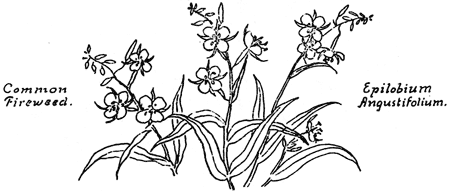|
Volume VIII No. 2 - August, 1935
Latest Flowering Plants In Crater Lake National Park
By Elmer I. Applegate, Ranger-Naturalist
In common with other regions of high altitude, the flowering time
for plants in the Park is relatively short. The seasons vary greatly,
depending largely upon the snowfall. While nearer normal, the present
is at least a month later than last year.
The earliest flowers to appear are normally in the lower levels.
Many of these have a comparatively longer flowering season and a greater
altitudinal as well as geographical distribution, following up to higher
levels with the advance of the season. Of these, Phlox Douglasii
(Douglas's Phlox) is a noteworthy example. In the Lava Beds Monument it
was out during the month of May; a month later it was in flower in the
yellow pine zone of the Park, and late in July it was in all its glory
on the lower slopes of the Watchman and the pumice fields to the north
and westward. Even as late as the middle of August this ubiquitous
plant will follow the last of the lingering snow-drifts farther up the
slope.
Of the earliest and more fleeting flowers to appear in the hemlock
zone, might be mentioned the yellow Erythronium (E. grandiflorum
pallidum) which adds much to the floral beauty of Sun Creek Valley,
and the Western Windflower (Anemone occidentalis), so
attractively decorating the first bare spots at the entrance of Castle
Creek Garden. In their restricted habitats, they come immediately after
the disappearance of the snow, and follow closely the retreating drifts,
their season being regulated by the depth.
A number of the more conspicuous plants are not in flower until the
season is considerably advanced, or even well into the second half.
These, for the most part, continue to flower until early snowfall. As
common elsewhere, members of the Aster family dominate. Of these, one
of the most widely distributed and attractive perennials is Engelmann's
Aster, sometimes know as Colville's Aster. The many tall leafy stems
form large rounded or spreading clumps. By the latter part of August
the purple flower-heads will add much to the color of the pumice flats
and slopes, notably about Government Camp and the Rim area.
Intermingled with it, or dominating some areas, will be bright
golden-yellow spots and patches of Bloomer's Rabbit Brush
(Chrysothamnus bloomeri). In less abundance is the gray-leaved
Rabbit Brush (C. nauseosus speciosus). On the slopes of Garfield
Peak it can be seen along the trail. Just at this time one of the most
attractive of the late bloomers is the Western Boneset (Eupatorium
occidentale). This, with its many-stemmed pink or lavender-colored
flower-heads, is rather abundant and especially noticeable on the lava
flows of Wizard Island, and more common along the rocky lake shore at
the Wine Glass. Everywhere on the pumice fields of the upper areas, is
the Pyrola-leaved Eriogonum (E. pyrolifolium). By the first of
August, the tall corn-like stalks of the green False Hellebore
(Veratrum viride) with their panicles of greenish-white flowers
will be much in evidence, and the pink-flowered common Fireweed
(Epilobium angustifolium) will be at its best. The Silver Plant
(Raillardella argentea) forms shining silvery mats on the higher
summits. More rare and seldom seen by visitors to the Park, are the
bog-loving Parnassia intermedia with its white buttercup looking
flowers, and the beautiful little gentian (Gentiana simplex). with
its single deep blue flower. These two plants are to be found at
Boundary Spring and Copeland Creek. It is interesting to note that the
common sagebrush (Artemisia tridentata) which contributes so much
to the gray color of the plaints and deserts of the west, occurs on the
dry talus slope of the crater wall at the Wine Glass. There it is
associated with the yellow pine and other plants of the Transition life
zone. It will not be in flower before the last of August, which is
about the time it will be out in the Lava Beds area.

|

